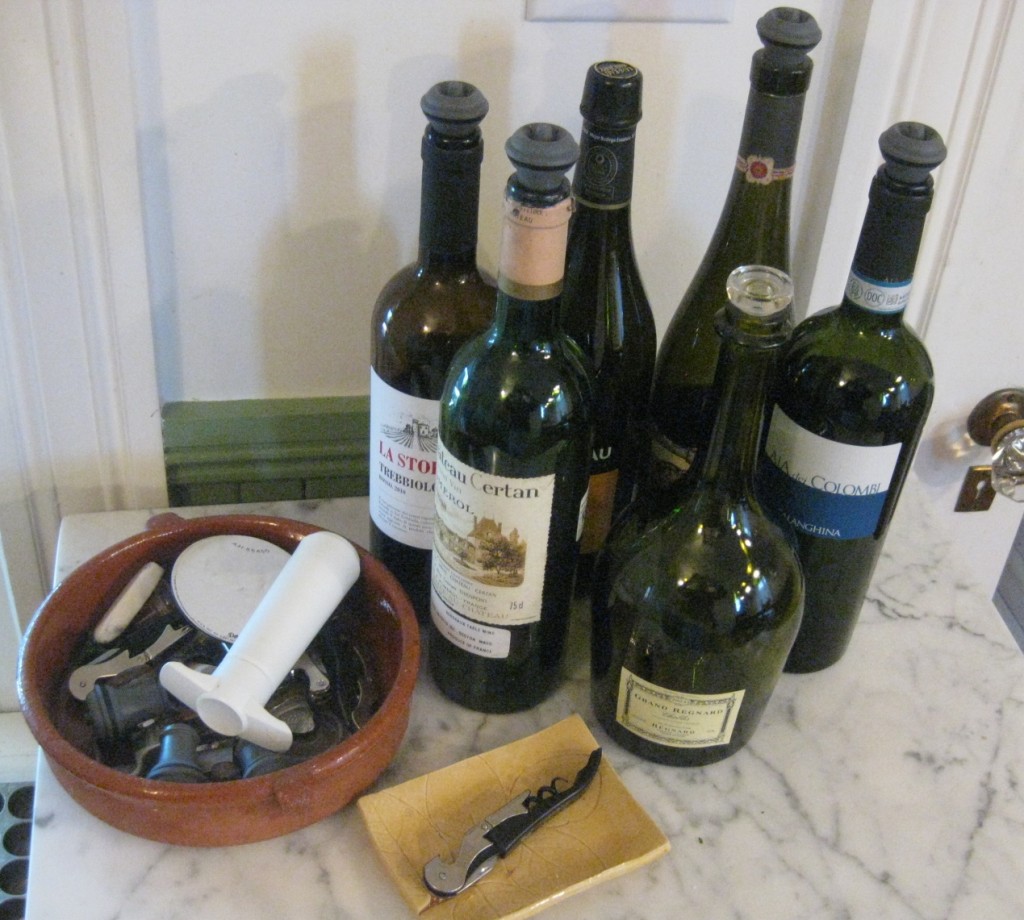THE COLLECTION of open wine bottles at left was shot in my kitchen this week. There are usually four to six there at a time. All are in the process of being nipped at. Chances are one or two will make their way to the recycle bin tonight – either because they’ve been emptied or because the inch or two of wine left in the bottom is no longer fresh enough to finish up. Why so much open wine? Because we rarely open one bottle at a time, or finish what we open in one, two, or even three nights. I’ll explain why.
One of the pleasures of keeping even a small cellar is the opportunity to trace the evolution of wine over an extended period. Depending on the quality of the wine, it will generally improve for some time, reach a peak and then begin a slow decline. The idea isn’t to drink it at some imagined peak so much as to observe the arc of its development. The process is interesting, instructive, and entertaining.
It isn’t just the passage of time or the peace and quiet of the cellar that sets all this in motion. It’s the exposure to minute amounts of oxygen either present in the wine or confined in the headspace (ullage) of the bottle. Under these conditions even unexceptional wines should improve for a few years before eventually deteriorating.
What happens slowly in a stoppered, cellared bottle is accelerated dramatically once the stopper is removed and wine is exposed to the air. The sudden draft of oxygen triggers changes to its chemistry, some of which occur in minutes, but others – often very interesting ones — take hours or days. It’s with a view to observing these shifts that we got in the habit of keeping several bottles open in our kitchen all the time.
It’s the same at Central Bottle, of course, and regular visitors to our weekend tasting table know that we’re often still sampling and talking about a bottle we opened at Thursday Night Wine Bar. Every once in a while the benefits of this approach hit with striking force. This was the case for me last week when a group of red wines we opened on a Thursday initially seemed rather constrained, but in 24 hours had morphed into something else entirely. One that had seemed mute was now a regular Chatty Cathy. In another, fruit that had barely emerged was now supple and gratifying. Two were still drinking beautifully on the third day.
The evolution of an opened wine follows an arc similar to cellared wine: incremental improvement followed by stasis followed by decline. It’s just that the process of years is condensed into hours — like time lapse photography — and it happens, so to speak, right before your eyes.
A simple vacuum pump (consider the Vacu-Vin Wine Saver for this purpose) keeps opened bottles from going off too, too quickly. The tool not only allows you track the evolution of a wine over several days but ensures you’ll have several, rather than a single wine, to sip with your supper from night to night. Setting the bottle in the fridge will slow things down further, but then you have to let it return to drinking temperature. Keep in mind that every open and re-close takes its toll.
Another benefit: Learning about the lifecycle of an opened bottle will sharpen your sense of just how fresh that glass of wine you order at the bar is. And when some inattentive server pours you something so worn out it belongs on a salad instead of in a glass, you’ll be able to tell her so.
Reach me at stephenmeuse@icloud.com
